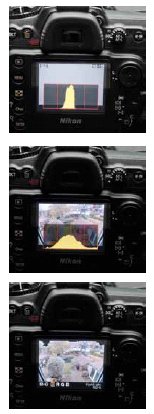articles/Cameracraft/expstrat-page5
Exposure Strategies - part 5 of 1 2 3 4 5 6
by Mike McNamee Published 01/12/2013

TOP: The histogram of a grey card centred on the mid-point of the histogram.
MIDDLE: A bland scene with a range of tones, centred in the histogram with a small amount of clipping on the extreme right of the histogram (the thin vertical yellow line).
BOTTOM: The highlight warning is turned on and flashes in the top corner portions of the sky. Even on a very dull day the sky is recorded as clipping.
Imagemaker professional
102 70
The clipping indicator of the camera is relatively crude depending upon an sRGB rendering of the Raw file. It also varies with camera model and make.
Adobe Camera Raw is more discerning, the clipping indicator kicks in at 254 RGB points. In our test image (8163) the ACR clipping has kicked in for the yellow patch of the SG Chart when the mid-grey swatch was reading 145 RGB points, nominally 0.4 stops over-exposed. The whites are at 248 RGB points as shot (the image was exposed at -0.33 stops from the camera assessment). As the table indicates, in ProPhoto RGB there was no clipping in the image, although yellow, red and orange were clipped in sRGB but only in the red channel - the argument here being that the green and blue channels would have supplied image detail. For a Macbeth SG target correctly exposed to give 121 RGB points on the mid-grey, the average RGB values of the chart is about 90 points. This difference of 31 points (121 minus 90) represents about 7/10 of a stop which is in accord with the camera delivering an over-exposed image when left to adjust its own exposure aimed at a Macbeth Chart. Overall those shots that were over-exposed and then taken back in ACR performed equally or better than the shot made at the 'correct' exposure. This validates the ETTR concept but in truth there is very little to choose between the various levels of exposure which are close to optimum. The one thing that does stand out is that you truly over-expose at your peril; once you go beyond about 1 1/2 stops of over-exposure (that is a grey card measuring around190 RGB points) things go badly wrong very quickly. Expose to the right by all means but be ever vigilant about pushing things too far!
Conclusions
As we might have predicted, ETTR works; it has, after all, stood the test of time. The truth is though that any exposure within about a stop is going to deliver commercially acceptable images providing the contrast range of the scene is not too high. Sadly though, in most sunlit circumstances, the range is too high and the photographer has to make fudges and compromises; we hope the feature has shed some light onto it. One piece of advice remains as true as ever (and even more so with the effectively zero cost digital shooting) - 'when in doubt bracket'. Set your camera to shoot three frames 1-stop apart and use high-speed motor drive at the decisive moment. If needed you can then recover most of the dynamic range at the cost of some extra time (it wall also, along the way provide insurance against blinkers!).
Please Note:
There is more than one page for this Article.
You are currently on page 5
- Exposure Strategies page 1
- Exposure Strategies page 2
- Exposure Strategies page 3
- Exposure Strategies page 4
- Exposure Strategies page 5
- Exposure Strategies page 6
1st Published 01/12/2013
last update 21/07/2022 08:46:24
More Cameracraft Articles
There are 6 days to get ready for The Society of Photographers Convention and Trade Show at The Novotel London West, Hammersmith ...
which starts on Wednesday 14th January 2026










